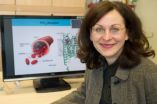(Press-News.org) PITTSBURGH, April 30, 2014 – Damaged leg muscles grew stronger and showed signs of regeneration in three out of five men whose old injuries were surgically implanted with extracellular matrix (ECM) derived from pig bladder, according to a new study conducted by researchers at the University of Pittsburgh School of Medicine and the McGowan Institute for Regenerative Medicine. Early findings from a human trial of the process and from animal studies were published today in Science Translational Medicine.
When a large volume of muscle is lost, typically due to trauma, the body cannot sufficiently respond to replace it, explained senior investigator Stephen F. Badylak, D.V.M., Ph.D., M.D., professor of surgery at Pitt and deputy director of the McGowan Institute, a joint effort of Pitt and UPMC. Instead, scar tissue can form that significantly impairs strength and function.
Pig bladder ECM has been used for many years as the basis for medical products for hernia repair and treatment of skin ulcers. It is the biologic scaffold that remains left behind after cells have been removed. Previous research conducted by Dr. Badylak's team suggested that ECM also could be used to regenerate lost muscle by placing the material in the injury site where it signals the body to recruit stem and other progenitor cells to rebuild healthy tissue.
"This new study is the first to show replacement of new functional muscle tissue in humans, and we're very excited by its potential," Dr. Badylak said. "These are patients who can't walk anymore, can't get out of a car, can't get up and down from a chair, can't take steps without falling. Now we might have a way of helping them get better."
For the Muscle Tendon Tissue Unit Repair and Reinforcement Reconstructive Surgery Research Study, which is sponsored by the U.S. Department of Defense and is continuing to enroll new participants, five men who had at least six months earlier lost at least 25 percent of leg muscle volume and function compared to the uninjured limb underwent a customized regimen of physical therapy for 12 to 26 weeks until their function and strength plateaued for a minimum of two weeks.
Then, study lead surgeon J. Peter Rubin, M.D., UPMC Professor and chair of plastic surgery, Pitt School of Medicine, surgically implanted a "quilt" of compressed ECM sheets designed to fill into their injury sites. Within 48 hours of the operation, the participants resumed physical therapy for up to 26 additional weeks.
The researchers found that three of the participants, two of whom had thigh injuries and one a calf injury, were stronger by 20 percent or more six months after the surgery. One thigh-injured patient improved on the "single hop test" by 1,820 percent, and the other had a 352 percent improvement in a chair lift test and a 417 percent improvement in the single-leg squat test. Biopsies and scans all indicated that muscle growth had occurred. Two other participants with calf injuries did not have such dramatic results, but both improved on at least one functional measure and said they felt better.
"This work represents an important step forward in our ability to repair tissues and improve function with materials derived from natural proteins. There will be more options to help our patients," Dr. Rubin said.
The study also showed six months after an injury, mice treated with ECM showed signs of new muscle growth while untreated mice appeared to form typical scars.
INFORMATION:
The research team includes lead authors Dr. Rubin and Brian M. Sicari, Ph. D., and others from Pitt and the McGowan Institute for Regenerative Medicine. The project was supported by research grants from the U.S. Department of the Interior; and National Institutes of Health grants AG042199 and HL76124-6.
For more information about the trial, which aims to enroll 40 participants, go to http://www.mirm.pitt.edu/badylak/clinical/muscle.asp or call 412-624-5308.
The U.S. Department of Defense's Limb Salvage and Regenerative Medicine Initiative and the Muscle Tendon Tissue Unit Repair and Reinforcement Reconstructive Surgery Research Study is collaboratively managed by the Office of the Secretary of Defense. The Initiative is focused on rapidly and safely transitioning advanced medical technology in commercially viable capabilities to provide wounded warriors the safest and most advanced care possible today.
About the University of Pittsburgh School of Medicine
As one of the nation's leading academic centers for biomedical research, the University of Pittsburgh School of Medicine integrates advanced technology with basic science across a broad range of disciplines in a continuous quest to harness the power of new knowledge and improve the human condition. Driven mainly by the School of Medicine and its affiliates, Pitt has ranked among the top 10 recipients of funding from the National Institutes of Health since 1998. In rankings recently released by the National Science Foundation, Pitt ranked fifth among all American universities in total federal science and engineering research and development support.
Likewise, the School of Medicine is equally committed to advancing the quality and strength of its medical and graduate education programs, for which it is recognized as an innovative leader, and to training highly skilled, compassionate clinicians and creative scientists well-equipped to engage in world-class research. The School of Medicine is the academic partner of UPMC, which has collaborated with the University to raise the standard of medical excellence in Pittsburgh and to position health care as a driving force behind the region's economy. For more information about the School of Medicine, see http://www.medschool.pitt.edu.
http://www.upmc.com/media
Contact: Anita Srikameswaran
Phone: 412-578-9193
E-mail: SrikamAV@upmc.edu
Contact: Rick Pietzak
Phone: 412-864-4151
E-mail: PietzakR@upmc.edu END
Regenerative medicine approach improves muscle strength, function in leg injuries
2014-04-30
ELSE PRESS RELEASES FROM THIS DATE:
Frozen meal eaters get more vegetables including greens, beans and whole grains but with lower total calories vs. fast food restaurant eaters
2014-04-30
SAN DIEGO (April 30, 2014) – New analysis of data from the 2003-2010 What We Eat In America (WWEIA) National Health and Nutrition Examination Survey (NHANES), a program of the Centers for Disease Control and Prevention (CDC), indicates that consumers of frozen meals (1) compared to consumers of quick service restaurant (QSR) meals (2) had lower calorie intakes and better Healthy Eating Index (HEI) score. In fact, the analysis revealed that those who consumed frozen meals consumed 253 fewer calories than those who consumed a quick service restaurant meal.
These results ...
Competition for ecological niches limits the formation of new species
2014-04-30
The rate at which new species evolve is limited by competition for ecological niches, report scientists from the University of Chicago in Nature on April 30. The study, which analyzes the evolutionary and genetic relationships between all 461 songbird species that live in the Himalayan mountains, suggests that as ecological niches within an environment are filled, the formation of new species slows or even stops.
To study what controls the process of speciation, Trevor Price, PhD, professor of ecology and evolution at the University of Chicago, Dhananjai Mohan of the ...
Initial research: Mango's effects on ulcerative colitis & bone parameters in animal models
2014-04-30
SAN DIEGO, CA – April 30, 2014 – Three new mango-related studies were presented this week at the 2014 Federation of American Societies for Experimental Biology (FASEB) in San Diego, revealing initial findings on the effects of mango consumption on ulcerative colitis and bone parameters in animal models.
"The mango industry's nutrition research program is committed to advancing our understanding of the role mangos can play as part of a healthy diet," said Megan McKenna, Director of Marketing for the National Mango Board. "These studies provide important insights that ...
Multiple consecutive days of tornado activity spawn worst events
2014-04-30
WEST LAFAYETTE, Ind. - Significant tornado outbreaks and especially strong tornadoes are more likely occur within periods of activity lasting three or more days, according to a Purdue University tornado expert.
Jeff Trapp, a professor of earth, atmospheric and planetary sciences, examined 30 years of U.S. weather records and found that an outbreak of 20 or more reported tornadoes had a 74 percent probability of occurring during a period of tornado activity lasting three or more days. During those same periods, a tornado rated 3 or higher on the Enhanced Fujita scale had ...
MS researchers find brain & cognitive reserve protect long-term against cognitive decline
2014-04-30
West Orange, NJ. April 30, 2014. Multiple sclerosis researchers have found that brain reserve and cognitive reserve confer a long-term protective effect against cognitive decline: Sumowski JF, Rocca MA, Leavitt VM, Dackovic J, Mesaros S, Drulovic J, Deluca J, Filippi M. Brain reserve and cognitive reserve protect against cognitive decline over 4.5 years in MS. Neurology. 2014 Apr 18. doi: 10.1212/WNL.0000000000000433 [Epub ahead of print]. James Sumowski, PhD, lead author of the article, and John DeLuca, PhD, are at Kessler Foundation. Co-authors are from the Manhattan ...
'US Should significantly reduce rate of incarceration,' says new report
2014-04-30
WASHINGTON -- Given the minimal impact of long prison sentences on crime prevention and the negative social consequences and burdensome financial costs of U.S. incarceration rates, which have more than quadrupled in the last four decades, the nation should revise current criminal justice policies to significantly reduce imprisonment rates, says a new report from the National Research Council.
A comprehensive review of data led the committee that wrote the report to conclude that the costs of the current rate of incarceration outweigh the benefits. The committee recommended ...
Seeing the bedrock through the trees
2014-04-30
University of California, Berkeley, geologist William Dietrich pioneered the application of airborne LIDAR – light detection and ranging – to map mountainous terrain, stripping away the vegetation to see the underlying ground surface.
But that didn't take him deep enough. He still couldn't see what was under the surface: the depth of the soil, the underlying weathered rock and the deep bedrock.
He and geology graduate student Daniella Rempe have now proposed a method to determine these underground details without drilling, potentially providing a more precise way to ...
Hope for better drugs to treat stroke and heart attacks
2014-04-30
An international team of researchers in cooperation with the University of Bonn has taken two "snapshots" of a receptor which are of critical importance for blood coagulation. The scientists now hope to be able to develop novel drugs using these results. These include tailor-made blood-thinning substances for heart attack and stroke patients whose effects are reversible and better controllable than those of current therapies. The researchers are presenting their results in the renowned journal "Nature."
After a cut to the finger, blood platelets come into play: they adhere ...
Should the EU ban on the import of seal products stand?
2014-04-30
Next month, following an appeal by Canada and Norway to overturn the EU ban on the import of seal products, the World Trade Organization (WTO) is expected to announce whether the 2013 decision will be upheld. In an editorial article, a University of Bristol academic, whose research on the animal welfare of the seal hunt has been used in the case, explains why the ban should stand.
The article by Dr Andy Butterworth, Senior Lecturer in Animal Sciences at the University of Bristol's School of Veterinary Sciences and an official observer of the seal hunt is published in ...
Prostate cancer and blood lipids share genetic links
2014-04-30
Numerous studies have suggested a relationship between cardiovascular disease risk factors and prostate cancer. A new study by researchers at the University of California, San Diego School of Medicine, with colleagues in Norway, significantly refines the association, highlighting genetic risk factors associated with low density lipoprotein (LDL) cholesterol and triglycerides as key players and identifying 17 related gene loci that make risk contributions to levels of these blood lipids and to prostate cancer
The findings, published in the April 30, 2014 online issue of ...


